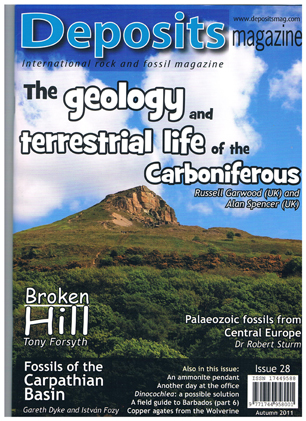Deposits Magazine- the International Rock and Fossil Magazine
As subscribers to the Deposits magazine we thought it high time that we wrote a brief review on this quarterly bulletin which concerns itself with all things related to geology, palaeontology and fossil collecting. Team members at Everything Dinosaur have been readers for some time but as yet we have not put anything down in print with regards to this particular publication. However, with the threat to the foreshore at Bracklesham Bay (West Sussex) we could effectively “kill two birds with one stone” as it were, combining a review with a bit of publicity concerning the campaign to save the Bracklesham Bay site as a location for family fossil hunts.
Deposits Magazine
First the review of Deposits. This is a full colour glossy, fifty-two page high quality Earth science magazine. It is aimed at both beginners, enthusiasts and professionals. The magazine has gained a strong reputation worldwide, for its superb quality of articles in topical areas. Certainly, each issue does cover a great deal of ground (no pun intended). Take for example issue 28 (Autumn 2011) which ever since its arrival before Christmas, it has been in residence in our board room available for all the staff to read. In this particular edition, topics covered include an insight into the working day of a North Sea wellsite geologist, Palaeozoic fossils to be found in the southern Alps of Austria, ammonites from New Guinea and the last part of a highly informative overview of the geology of Barbados.
The Front Cover of Deposits Magazine
Picture credit: UKGE
Aimed at the General Reader
One of the great benefits of this magazine, is that it is written for the general reader. Technical areas of geology are discussed using terms and concepts that everyone including casual fossil collectors can understand. Scientific papers are summarised in such a way that much of the technical language is removed thus permitting all readers to learn about new discoveries and such like. We at Everything Dinosaur, try to do the same for aspects of vertebrate palaeontology within this humble web log, so we greatly appreciated the efforts of the editorial team behind this excellent publication.
An example of this would be the article on the fossils of the Carpathian Basin (a substantial and highly fossiliferous region of eastern Europe covering Hungary, Romania, Slovakia, Ukraine, Slovenia, the Czech Republic and portions of Austria). The authors of what will be a series of articles about the Carpathian Basin (Gareth Dyke and Istvan Fozy), have provided a well-written and hugely enjoyable article and we look forward to reading more about this fascinating area of eastern Europe in future issues of the magazine.
Now for the plea for help. The foreshore at Bracklesham Bay running to Selsey in West Sussex is under threat and could potentially be closed to fossil collectors. The local district council intends to close the beach to families, visitors and fossil collectors to the east of the Bracklesham car park, as they want to designate this area as a kite surfing zone.
Bracklesham Bay
We know the Bracklesham Bay area very well, although it has been a few years since we visited this site whilst in the Chichester area. It is a beautiful part of the world and a very popular location for fossil collectors as the foreshore has abundant fossils, bivalves, sharks teeth, teeth from rays, gastropods etc. all dating from the Palaeogene Period (50-45 million years ago). The site has easy access and fossils can simply be picked up off the beach, it is a great location for families and many a young fossil collector has started their collection and fired their enthusiasm for geology after a visit to this part of West Sussex. Proposed changes to sea defences are already threatening the site, but if the Bracklesham Bay site is closed to fossil collectors this would be a great shame.
Whilst we accept that this location is also very popular with wind surfers and surfers, it remains one of the most family friendly fossil hunting locations in the whole of southern England and as such if this site or part of it were to be closed to families, then this would be extremely sad.
For models and replicas of iconic animals from the fossil record including belemnites and ammonites: Replicas of Iconic Fossil Animals and Models.



Leave A Comment